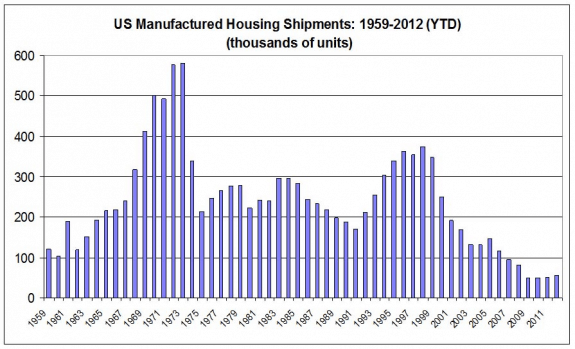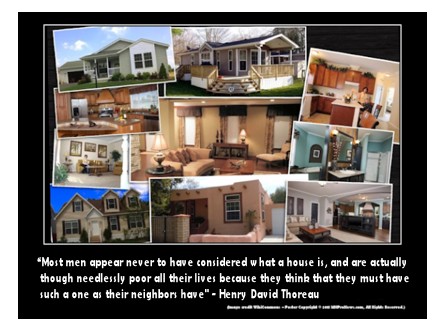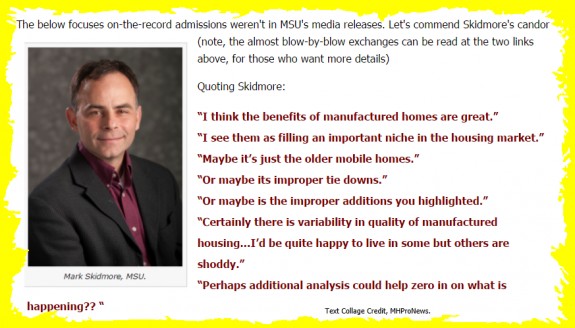
Flashback to Flash Forward…
While many mobile home builders in those pre-HUD Code days took the long view and built to reasonable construction and safety standards – such as the ANSI standards available then – other producers were less diligent about quality and customer satisfaction. 60 Minutes and others in media profiled consumer complaints.
Regrettably, as can happen, the good got lumped in with the bad.
The media and public ‘hue and cry’ led a coalition of builders to push for federally preemptive standards. Those were passed by Congress in 1974. Those standards took effect on June 15, 1976, the day when the first official manufactured homes were produced.
So as all industry professionals ought to know, mobile homes and manufactured homes are not the same thing. Important safety, quality, energy and durability features were all “born” with the HUD Code for manufactured housing.

Why It Matters
As Steve Duke with the Louisiana Manufactured Housing Association (LMHA) told MHLivingNews, “The terminology matters because the terminology determines the construction standards a home was built to.”
Terminology and its meaning with respect to pre-Code, post-HUD Code for manufactured home standards is precisely the hinge that creates headache issues for researchers, public officials and home buyers.
While many in the industry focus on the SEO value of ‘mobile homes,’ which doesn’t have to be ignored, they may fail to see that ‘mobile homes’ and ‘trailer houses’ have such a distaste with the bulk of the public, that it has tainted the manufactured home industry.
That in turn is one of several factors that have depressed manufactured home sales, as MHProNews and our sister site, MHLivingNews, have carefully documented over the years.

Real World Examples of How the Public Views ‘Mobile Homes’
“Do not buy a manufactured home, if this was a real tornado, this house would (be) gone in 60 seconds or less. wow! the things people do to make a dime. geez!” – Robert Delacerda, said in a post on YouTube.
Replying to a comment by ‘Root Beer,’ Delacerda elaborated by saying, “well said sir, mobile homes are weak and made of cheap materials. a tornado of f-0 [sic] would destroy this shack in a vlink [sic] of a eye. funny video though.”
Duane Dean posted, “We live in a newer (1993) single wide mobile home and its anchored. The work I have done myself on this place just make me quiver to think anyone would ever stay in one during any tornado.”
There have been pro-MH comments on the video too; one example of common sense was from a man who said he’s a Joplin firefighter.
Aegeus Max, said, “…as a Joplin firefighter that worked the debris I can tell you that it is not safe anywhere in a tornado except underground. The neighborhood I worked was an upscale all with basements…”
It will take repeated efforts to clear up the confusion. Even having read Max’s statement, James Dennis replied, “But still, if I live in a M home or a mobile home and I see a tornado I’m getting in the car and driving to a shelter or getting out of the path of the tornado.”
When we look at the low conversion ratios of those shopping for modern manufactured home vs. those that actually buy, industry professionals have said to this writer for years that fear of tornadoes is one of the biggest issues.
This is why the research and videos MHLivingNews and MHProNews have done – in conjunction with industry professionals, sponsors and supporters – on this issue are useful and important. Those selling to actual home shoppers have told us that when they show someone “on the fence” that has expressed fears about windstorm one of our videos, it has often caused the skeptics to buy.

Chris Noah, who identified himself as a manufactured home (MH) owner, and on the same YouTube video as the others quoted above, posted this: “we have had straight line storms with winds in access of 80mph, we also on a hill with no wind breaks, and no problems here…”
MH owner Noah found encouragement from that early video, and he also stood up to those who were belittling their lack of understanding about manufactured homes, with his own experiences.
We have, through debates and discussions, turned some nay-sayers into silence, actual or potential believers. But in the absence of engaging and changing minds, there are comments like this one this week:
ArmyGuy63Bravo1 said, “im gonna open the “tornado magnet trailer park” soon with free rent for 3 months.” (Typos in the original).
Do we wonder why zoning officials have a problem with the public pushing back on new development, expansions or placement of manufactured homes in their jurisdictions?
Only education – repeated, on-going education – can change those kinds of patterns of false impressions. One press release one time isn’t enough.
A new video was posted on YouTube that updated the one Noah and the others have seen. This new video posted on YouTube is shown below.
Anniversaries for the ‘birthday’ of the HUD Code for manufactured homes are useful times to engage in such education.
People Want Facts, Not Hype and Claims
This goes to a point raised by community partner Tom Fath in his video interview. Fath says that home owners want to be part of the solution for misunderstandings about the industry. That’s the value Fath says that MHLivingNews provides to residents and homeowners. They have happier, better informed residents as a result.
Those residents – along with those videos they can point shoppers to – are in turn causing more people to buy.
Their sales have skyrocketed as a result. Or as Deer Valley Homebuilders James McGee and Chet Murphree said in an previous video interview, “Tony, we know that it’s all about education…thank you for leading the charge for that…”
That’s a key point of doing videos and stories; to help doubters see the reality vs. the overhyped fears. But there is more of it needed. This is why the engagement with MSU researchers we did with MHARR is so important to the industry. See the summary of that debate, linked here.

Researchers all-too-often don’t know the factual difference between mobile homes and manufactured homes. That’s how poor a job overall the industry has done with getting out the facts about Ron Thomas Sr.’s reference to manufactured housing as a “phenomenon,” but one that is misunderstood by many public officials, lenders, and millions of others.
About the 41st Birthday of Manufactured Homes
“The establishment of the HUD Code was — and is — an important milestone for both the industry and consumers. The industry itself sought out federal regulation under a preemptive, performance-based, uniform code of federal standards that balances the key factors of safety and cost, along with uniform enforcement within a federal-state partnership,” said Mark Weiss, President and CEO of the Manufactured Housing Association for Regulatory Reform (MHARR).
“This type of federal regulation — so long as it is reasonable — allows the industry to pass-along the efficiencies of factory-construction to home buyers, in the form of unparalleled affordability and quality,” Weiss said.
He elaborated by saying that “today’s manufactured homes have achieved the level of quality, durability, and safety that Congress envisioned when it passed the National Manufactured Housing Construction and Safety Standards Act of 1974.” But he also said that for the industry to reach its potential, a shakeup of the HUD Program was needed by the Trump Administration. His full comments are linked here.
The Bottom Line
Industry business leaders and management professionals must be personally informed, and they in turn must engage their own teams in the best understanding of the need for and value of manufactured homes.
Professionals in turn must educate those that they encounter. This has to be a local market level effort. Tom Fath and his family, along with others, have proven that this is not only doable, its profitable ## (News, Analysis, Commentary).
(Editor’s Note: To see our 40th anniversary article – made for the public in mind – click here.)
(Image credits are as shown above, and when provided by third parties, are shared under fair use guidelines.)


























